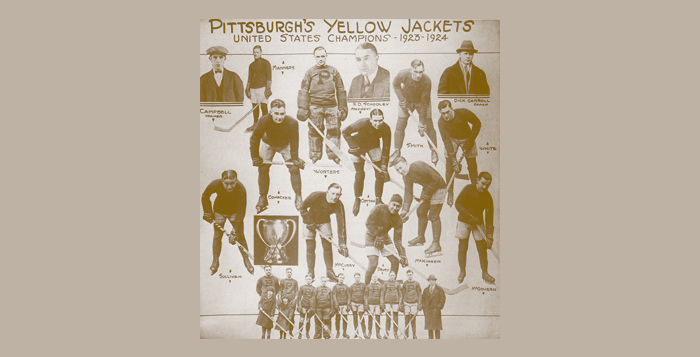This Day in Hockey History – October 25, 1920 – USAHA Not to Be Confused with AAHA
The United States Amateur Hockey Association was formed on October 25, 1920. The announcement was made in Philadelphia after a meeting, held at the Ice Palace, of hockey representatives from prominent hockey centers across the United States. Those attending the meeting decided that more supervision was needed over the sport and that such would be in the best interest of the game. Thus, a separate governing body should be formed in the United State, solely devoted to hockey.
“A resolution was adopted that the United States Amateur Hockey association will not admit to membership any team directly or indirectly controlled by rink owners: that every club admitted to membership must be self-governing, control its own finances and be in a position, when called upon, to give an accounting of same,” reported The Pittsburgh Press.
Prior to the formation of the USAHA, the International Skating Union (ISU) oversaw hockey in the United States. The ISU had agreements with the Amateur Athletic Union (AAU) and the Canadian Amateur Hockey Association (CAHA). The ISU was asked to approve the five-city plan and to recommend that the AAU recognize the new organization as the governing body for hockey in the U.S., as the ISU would turn over control of the sport to the new association. With the approval of the AAU, the ISU passed the resolution and as a result the USAHA was affiliated with both groups. This allowed the newly formed USAHA to play teams from both the AAU and the CAHA.
Officers were elected: President, W.S. Haddock of Pittsburgh, Vice Presidents, George V. Brown of Boston and J. Edward Fitzgerald of St. Paul, secretary, Roy D. Schooley of Pittsburgh. The executive committee consisted of one representative from each city in the association.
Initially, the new association was made up of eight teams, representing Boston, Philadelphia, Pittsburg (Pittsburgh Yellow Jackets), Cleveland, New York City, and three from Minnesota: Duluth, Eveleth and St. Paul. Additional clubs were added later in the year from Boston (Boston Athletic Association), Milwaukee, Minneapolis, and Pittsburg (Fort Pitt Hornets). Teams in Calumet, Houghton and Sault Ste. Marie, Michigan transferred from the American Amateur Hockey Association.
The USAHA was divided into three divisions during the first two seasons, the East, Midwest and Northwest. In 1922, the USAHA operated using two divisions, Eastern and Western. Canadian players dominated the association, apart from upper Michigan. Team rosters were small with only seven to nine players. It wasn’t uncommon for a player to get no relief during a game and there wasn’t any goalie back up. Extra players often had to suit up to fill in for an injured goalie.
Issues plagued the USAHA: inconsistent referees, lack of suitable ice (as several teams relied on natural ice which forced teams to play on neutral ice outside their hometowns), and sizes of arenas which limited attendance in smaller cities.
The 1924-25 season was the last for the USAHA. Ongoing disagreements between the USAHA and CAHA went unresolved, leading to the cancellation of the articles of alliance between the USAHA and the CAHA.
“The agreement between the two factions had not worked out to the entire satisfaction of the Canadian officials, other practices allegedly performed by the U.S.H.A, were contratry <sic> to the good working spirit of the amateur rules,” wrote The Winnipeg Tribune.
But perhaps the final straw between the two organizations may have been comments from the U.S. organization that were directed to the Canadian group.
“The ruling regarding international hockey came after a letter had been read from the United States Amateur Hockey Association, in which it was stated that the United States body could run its own affairs independent of Canadian teams,” reported The Vancouver Sun.
Ultimately the USAHA was disbanded partway through the 1924-25 season. The Western Division reorganized and became the Central Hockey League, then the American Amateur Hockey Association in 1926. The Pittsburgh Yellow Jackets joined the National Hockey League.
Many future members of the Hockey Hall of Fame played in the USAHA. Hall of Famers include, Charlie Gardener, Nell Stewart, Moose Goheen, Ching Johnson, Tiny Thompson and Cooney Weiland, to name a few. Other players in the association went on to have long and successful careers in the NHL, AHA ad AHL.
Additional Sources:
- “New Amateur Hockey Association Formed,” Philadelphia Inquirer (Philadelphia, Pennsylvania), Tuesday, October 26, 1920, p. 14.
- “Amateur Hockey Circuit is Formed; Haddock New Head,” The Pittsburgh Press, Tuesday, October 26, 1920, p. 36.
- “Five Club Hockey League,” New-York Daily Tribune (New York, New York), Tuesday, October 26, 1920, p, 13.
- “Five Cities Comprise Amateur Hockey Asso.,” Patriot (Harrisburg, Pennsylvania), Tuesday, October 26, 1920, p, 11.
- “United States Amateur Hockey Association” Vintage Minnesota Hockey.
- “S.P. “Silver” Quilty Re-elected Leader,” Winnipeg Tribune (Winnipeg, Manitoba), March 25, 1925. p. 12.
- “Hockey War Declared,” Seattle Daily Times (Seattle, Washington), Wednesday, March 25, 1925, p. 19.
- Roger A. Godin, Before the Stars: Early Major League Hockey and the St. Paul Athletic Club Team (St. Paul, Minn.: Minnesota Historical Society Press, 2005), p.166-167.














